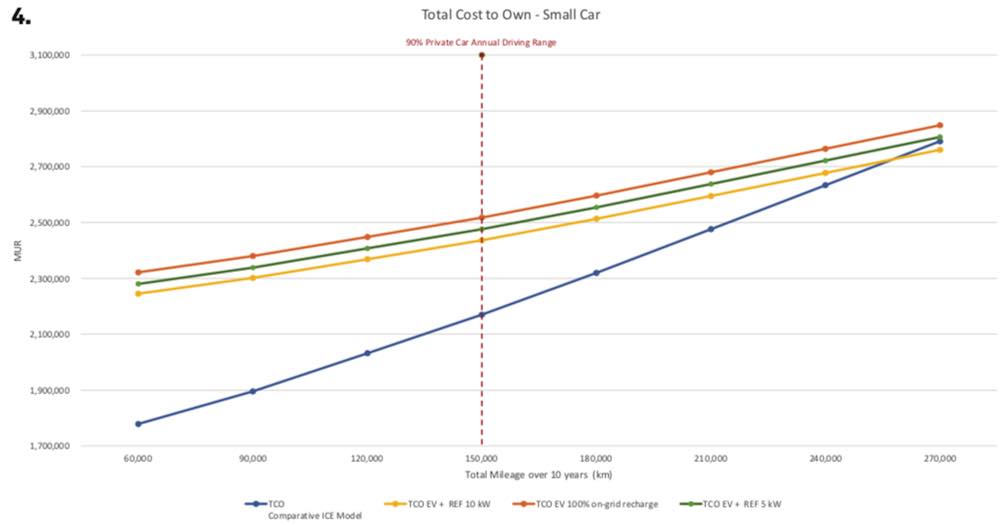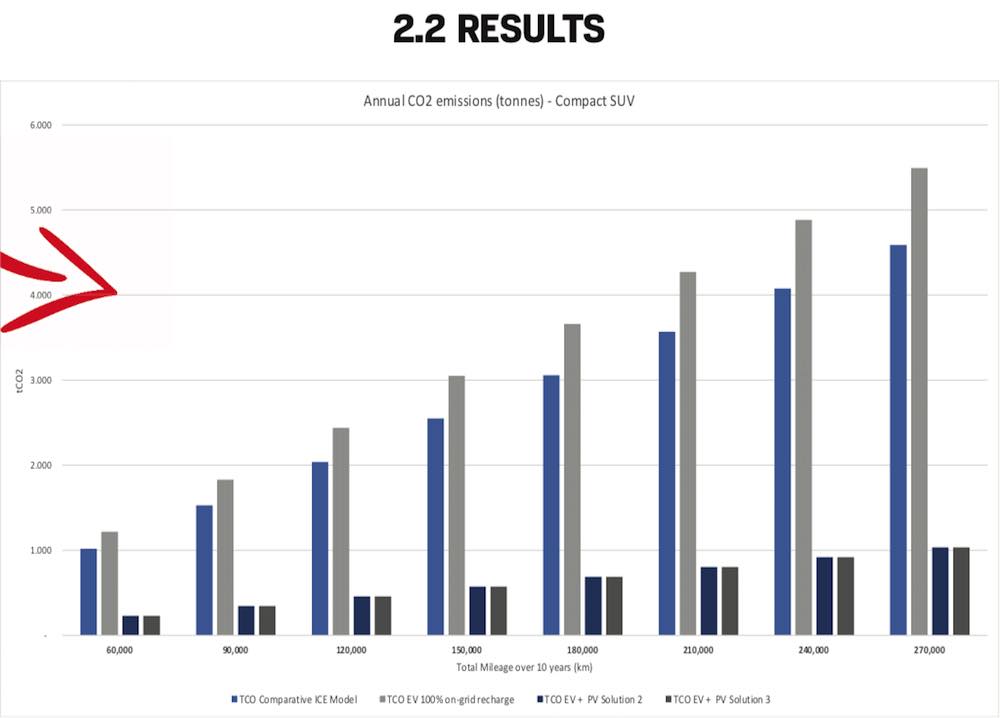
Electric Vehicles (EVs) are currently the hot talk in town. Do they make sense and if yes under what conditions? This article leverages on recent international studies and considers the matter within the Mauritian landscape under financial and environmental lenses.
Disclaimer 1: Due to the inherent format of a news-paper and the necessity to compact the information being published, this article 1.) has no claims to exhaustivity with regards to explaining the full context and the rationale behind all the assumptions which were made and 2.) makes use of some technical jargon which may not be understood by all without further references. The author has endeavored to be as didactic as possible though.
Disclaimer 2: All calculations are based on publicly available and/or verifiable information either locally or internationally.
Disclaimer 3: The article compares two categories of EV, namely small car and compact SUV with an equivalent gasoline engine vehicle (also known as ICEV – Internal Combustion Engine Vehicle). While he has sought to be as objective as possible, the author accepts that this exercise carries an incompressible element of subjectivity.
1.Financial perspective:
Cost of ownership of a vehicle is best understood through a TCO model (Total Cost to Own) which adds the running and operational costs to the purchase price. For a vehicle, the TCO calculation is given as follows: TCO=PP-RP+FC xTKD+BC+MR+T-S where TCO is the total cost of owner- ship for the ownership period, PP is purchasing price, RP is resell price in the end of the ownership period and the difference between PP and RP constitutes the depreciation of the vehicle. FC is fuel cost per kilometre, TKD is total kilometre driven, FC(TKD) is the total fuel cost, BC is the Borrowing Cost owed to a financial institution for payment of interests for a leasing/car loan, IC is insurance cost, MR is maintenance and repairs, T is government taxes and S is government subsidies.
1.1 Assumptions:
a.4 scenarios are established, namely: 1.) Equivalent ICEV 2.) EV with no Renewable Energy Facility (REF) and therefore on-grid charging 3.) EV with an on-gridREFof5kWand4.) EV with an on-grid REF of 10kW.
b.1st Ownership period is set at 10 years. This is deemed reasonable with regards to 1.) having a sustainable approach to ownership and 2.) the improved quality of vehicles (both ICEV & EV).
c.Financial calculations are computed at Present Value with a discount rate of 3%. In essence, the value of 1 rupee today is not the same as that of 1 rupee in the future due to depreciation. To do a sum total, future financial values have to be discounted at their present value with a discount rate which reflects “local financial markets performance”.
d.ICEV purchase price is inclusive of its excise duty at normal rates (current COVID-19 rates are not considered). Duty-free is a no-go.
e.Based on international research data, 1.) the depreciation curve is deemed to be the same for ICEV and EV, 2.) Insurance costs is set at 1.06 times higher for EV, 3.) Maintenance and Repair Costs is a function of mileage and is lower for EVs by 58% (0–80km range),53%(80– 160 km range) and 46% (160 – 320 km range).
f.Borrowing costs are calculated on the basis of 4.5% interest rate for EV, 5.5% for ICEV and 4.5% for REF. Borrowing is deemed to be 80% of purchasing price(s).
g.TKD (mileage) ranges from 20 km per day to 90km per day (round trip). Vehicle usage is 6 days per week or 300 days per year.
h.Ownership and borrowing costs of REF are apportioned to the amount of power used to charge the EV in the TCO model as compared to the total power generated by the REF. The remaining costs are considered to be apportioned to domestic electrical consumption and are therefore not included.
i.The grid operator (CEB) will accept the connection and purchase of domestic Renewable Energy production facilities on a gross metering basis with prices of Rs 3.50/ kWh for purchase and Rs 8.77/kWh for selling during non-production hours.
j.In the absence of a national EV charging infrastructure (and the time it will take to be implemented), EV owners are expected to charge their EVs at home during after-office hours which correspond to non-production hours for their REF.
k.Current EV battery technologies have an ave- rage energy conversion efficiency of 88%, that is 1 kWh of energy billed from the grid represents 0.88 kWh of energy stored in the battery.
l.Gasoline prices take into account inflation rates over time (source The Economist Intelligence Unit report on the Mauritian Economy).
m.In the absence of the new figures at the time of writing this article, road tax uses the current published values from NLTA.
n.USD-MUR exchange rate is at Rs 40.3.
o.Statistically, 90% of private car owners drive less than 15,000 km per year.
p.While loan subsidies can be obtained for EVs & REFs through some Financial institutions (FIs) which have green financing programmes (therefore these would lower the TCO for these items), the model does not include these elements in order to provide a fair comparison to all FIs.




1.3 Observations:
a.Car owners who drive under 15000 km annually (90% of private car owners) may not reap the financial benefits of owning an EV. It is more pronounced for small car buyers which are considered to be the main market for EVs as small cars are mostly used for intra-ur- ban/short trips which are the most polluting and damaging to health.
b.Point 1 arises mainly due to the large difference in purchase prices between EV and ICEV. As a general observation, prices of EVs in Mauritius are considerably higher than in other countries even if adjusted for considerations such as freight.
c.Investing into a REF leads to a lower TCO due to lower fuel costs. However, this positive effect could be amplified if the grid operator re-introduces its old net metering scheme (equal price for purchase and selling of kWh)
d.Other factors that can increase the attractiveness of EVs are 1.) Lower Bank Interest rates 2.) public policy alignment and 3.) providing loan subsidies or grants with however the right level of scrutiny to ensure that these do not flow to the car dealers through price tweaking.
e.While being more attractive due to a lower TCO, a combined EV+REF solution requires higher upfront investment and loan repay- ment capacity. This financial burden could be alleviated through adjusted policy-making so as to encourage additional owners to make the jump.
2.Environmental perspective:
This article focuses only on the emission of CO2 by the different scenarios. Let us first recall that in its NDCs (Nationally Deter- mined Contributions) submitted in response to the 19th and 20th sessions of the Conference of the Par- ties to the United Nations Framework Convention on Climate Change (UNFCCC), Mauritius has committed to reduce its CO2 emissions by 30% by 2030. Unfortunately, we are far from achieving this target as illustrated by these graphics):
2.1 Assumptions
a.Grid Emission Factor is 0.9545-> for every 1kWh produced, 0.9543 kg of CO2 is produced.
b.Transmission loss on the electricity grid is 10% -> for every 1 kWh generated, 0.9 kWh will reach the end- user.
c.Gasoline Emission Factor is 2.29 -> for every 1L of gasoline, 2.29 kg of CO2 is produced through tail-pipe emissions.
d.ICEV and EV fuel consumption index were taken from reputed online sources of information which provided real range consumption data.
e.Computation is on usage only and do not there- fore incorporate CO2 emissions for manufacturing EV, ICEV and REF. As a rule of thumb, EV manufacturing emits more CO2 than ICEV manufacturing.

2.3 Observations:
1.Surprisingly and most importantly, on-grid charging of EVs is more polluting than ICEV for all mileage scenarios. This is due to a carbon-rich electricity grid in Mauritius and things are not going to get better overnight. In the meantime, EV product offerings which do not incorporate a REF should be called out for what they are: Absolutely Not Green! And they do not contribute to the NDCs of Mauritius as provided above. This ecological failure should be addressed through policy-making.
2.The same computation could be applied to Electric Buses if data is made available. Most probably, similar results would be obtained and it is therefore important to guard against uninformed and costly decision-making.
3.EV coupled with an on-grid REF are not carbon-neutral due to grid transmission loss factor. They are however to be encouraged as they provide a significant reduction in CO2 emissions. It is suggested that public policymakers 1.) considers ways and means to alleviate the initial financial burden required to make such an investment and 2.) encourages the Grid Operator to come forward with a scheme at the earliest.


